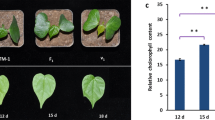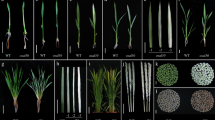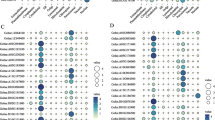Abstract
Carotenoids are important accessory pigments in plants that are essential for photosynthesis. Phytoene synthase (PSY), a rate-controlling enzyme in the carotenoid biosynthesis pathway, has been widely characterized in rice, maize, and sorghum, but at present there are no reports describing this enzyme in cotton. In this study, GhPSY was identified as a candidate gene for the red plant phenotype via a combined strategy using: (1) molecular marker data for loci closely linked to R1; (2) the whole-genome scaffold sequence from Gossypium raimondii; (3) gene expression patterns in cotton accessions expressing the red plant and green plant phenotypes; and (4) the significant correlation between a single nucleotide polymorphisms (SNP) in GhPSY and leaf phenotypes of progeny in the (Sub16 × T586) F2 segregating population. GhPSY was relatively highly expressed in leaves, and the protein was localized to the plastid where it appeared to be mostly attached to the surface of thylakoid membranes. GhPSY mRNA was expressed at a significantly higher level in T586 and SL1-7-1 red plants than TM-1 and Hai7124 green plants. SNP analysis in the GhPSY locus showed co-segregation with the red and green plant phenotypes in the (Sub16 × T586) F2 segregating population. A phylogenetic analysis showed that GhPSY belongs to the PSY2 subfamily, which is related to photosynthesis in photosynthetic tissues. Using a reverse genetics approach based on Tobacco rattle virus-induced gene silencing, we showed that the knockdown of GhPSY caused a highly uniform bleaching of the red color in newly-emerged leaves in both T586 and SL1-7-1 plants with a red plant phenotype. These findings indicate that GhPSY is important for engineering the carotenoid metabolic pathway in pigment production.








Similar content being viewed by others
References
Niyogi KK (1999) Photoprotection revisited: genetic and molecular approaches. Ann Rev Plant Physiol Plant Mol Biol 50:333–359
Hirschberg J (2001) Carotenoid biosynthesis in flowering plants. Curr Opin Plant Biol 4:210–218
Gady AL, Vriezen WH, Van de Wal MH, Huang P, Bovy AG, Visser RG, Bachem CW (2012) Induced point mutations in the phytoene synthase 1 gene cause differences in carotenoid content during tomato fruit ripening. Mol Breed 29(3):801–812
Fraser PD, Truesdale MR, Bird CR, Schuch W, Bramley PM (1994) Carotenoid biosynthesis during tomato fruit development. Plant Physiol 105(1):405–413
Shewmaker CK, Sheehy JA, Daley M, Colburn S, Ke DY (1999) Seed specific overexpression of phytoene synthase: increase in carotenoids and other metabolic effects. Plant J 20(4):401–412
Moehs CP, Tian L, Osteryoung KW, DellaPenna D (2001) Analysis of carotenoids biosynthetic gene expression during marigold petal development. Plant Mol Biol 45(3):281–293
Li F, Vallabhaneni R, Wurtzel ET (2008) PSY3, a new member of the phytoene synthase gene family conserved in the Poaceae and regulator of abiotic stress-induced root carotenogenesis. Plant Physiol 146(3):1333–1345
Li F, Vallabhaneni R, Yu J, Rocheford T, Wurtzel ET (2008) The maize phytoene synthase gene family: overlapping roles for carotenogenesis in endosperm, photomorphogenesis, and thermal stress tolerance. Plant Physiol 147(3):1334–1346
Cidade LC, de Oliveira TM, Mendes AF, Macedo AF, Floh EI, Gesteira AS, Soares-Filho WS, Costa MG (2012) Ectopic expression of a fruit phytoene synthase from Citrus paradisi Macf. promotes abiotic stress tolerance in transgenic tobacco. Mol Biol Rep 39(12):10201–10209
Dibari B, Murat F, Chosson A, Gautier V, Poncet C, Lecomte P, Mercier I, Bergès H, Pont C, Blanco A, Salse J (2012) Deciphering the genomic structure, function and evolution of carotenogenesis related phytoene synthases in grasses. BMC Genom 13:221
Busch M, Seuter A, Hain R (2002) Functional analysis of the early steps of carotenoid biosynthesis in tobacco. Plant Physiol 128(2):439–453
Maass D, Arango J, Wüst F, Beyer P, Welsch R (2009) Carotenoid crystal formation in Arabidopsis and carrot roots caused by increased phytoene synthase protein levels. PLoS One 4(7):e6373
Kachanovsky DE, Filler S, Isaacson T, Hirschberg J (2012) Epistasis in tomato color mutations involves regulation of phytoene synthase 1 expression by cis-carotenoids. Proc Natl Acad Sci USA 109(46):19021–19026
Zhao L, Cai C, Zhang T, Guo W (2009) Fine mapping of the red plant gene R1 in upland cotton (Gossypium hirsutum). Chin Sci Bull 54(9):1529–1533
Kohel RJ, Leuis CF (eds) (1984) Cotton. American Society of Agronomy, Madison
Paterson AH, Wendel JF, Gundlach H, Guo H, Jenkins J, Jin D, Llewellyn D, Showmaker KC, Shu S, Udall J, Yoo MJ, Byers R, Chen W, Doron-Faigenboim A, Duke MV, Gong L, Grimwood J, Grover C, Grupp K, Hu G, Lee TH, Li J, Lin L, Liu T, Marler BS, Page JT, Roberts AW, Romanel E, Sanders WS, Szadkowski E, Tan X, Tang H, Xu C, Wang J, Wang Z, Zhang D, Zhang L, Ashrafi H, Bedon F, Bowers JE, Brubaker CL, Chee PW, Das S, Gingle AR, Haigler CH, Harker D, Hoffmann LV, Hovav R, Jones DC, Lemke C, Mansoor S, ur Rahman M, Rainville LN, Rambani A, Reddy UK, Rong JK, Saranga Y, Scheffler BE, Scheffler JA, Stelly DM, Triplett BA, Van Deynze A, Vaslin MF, Waghmare VN, Walford SA, Wright RJ, Zaki EA, Zhang T, Dennis ES, Mayer KF, Peterson DG, Rokhsar DS, Wang X, Schmutz J (2012) Repeated polyploidization of Gossypium genomes and the evolution of spinnable cotton fibres. Nature 492(7429):423–427
Wang K, Wang Z, Li F, Ye W, Wang J, Song G, Yue Z, Cong L, Shang H, Zhu S, Zou C, Li Q, Yuan Y, Lu C, Wei H, Gou C, Zheng Z, Yin Y, Zhang X, Liu K, Wang B, Song C, Shi N, Kohel RJ, Percy RG, Yu JZ, Zhu YX, Wang J, Yu S (2012) The draft genome of a diploid cotton Gossypium raimondii. Nat Genet 44(10):1098–1103
Conesa A, Götz S (2008) Blast2GO: a comprehensive suite for functional analysis in plant genomics. Int J Plant Genomics 2008:619832
Jiang JX, Zhang TZ (2003) Extraction of total RNA in cotton tissues with CTAB-acidic phenolic method. Cotton Sci 15:166–167
Livak KJ, ∆ TD (2001) Analysis of relative gene expression data using real-time quantitative PCR and the 2−∆∆CT method. Methods 25(4):402–408
Eddy SR (2011) Accelerated profile HMM searches. PLoS Comput Biol 7(10):e1002195
Punta M, Coggill PC, Eberhardt RY, Mistry J, Tate J, Boursnell C, Pang N, Forslund K, Ceric G, Clements J, Heger A, Holm L, Sonnhammer EL, Eddy SR, Bateman A, Finn RD (2012) The Pfam protein families database. Nucleic Acids Res 40(Database issue):D290–301
Thompson JD, Gibson TJ, Plewniak F, Jeanmougin F, Higgins DG (1997) The CLUSTAL_X windows interface: flexible strategies for multiple sequence alignment aided by quality analysis tools. Nucleic Acids Res 25(24):4876–4882
Tamura K, Peterson D, Peterson N, Stecher G, Nei M, Kumar S (2011) MEGA5: molecular evolutionary genetics analysis using maximum likelihood, evolutionary distance, and maximum parsimony methods. Mol Biol Evol 28(10):2731–2739
Reese MG (2001) Application of a time-delay neural network to promoter annotation in the Drosophila melanogaster genome. Comput Chem 26(1):51–56
Higo K, Ugawa Y, Iwamoto M, Korenaga T (1999) Plant cis-acting regulatory DNA elements (PLACE) database: 1999. Nucleic Acids Res 27(1):297–300
Lescot M, Déhais P, Thijs G, Marchal K, Moreau Y, Van de Peer Y, Rouzé P, Rombauts S (2002) PlantCARE, a database of plant cis-acting regulatory elements and a portal to tools for in silico analysis of promoter sequences. Nucleic Acids Res 30(1):325–327
Zhang J, Guo WZ, Zhang TZ (2002) Molecular linkage map of allotetraploid cotton (Gossypium hirsutum L. × Gossypium barbadense L.) with a haploid population. Theor Appl Genet 105(8):1166–1174
Zhang J, Wu YT, Guo WZ, Zhang TZ (2000) Fast screening of microsatellite markers in cotton with PAGE/silver staining. Cotton Sci 12:267–269
Yoo SD, Cho YH, Sheen J (2007) Arabidopsis mesophyll protoplasts: a versatile cell system for transient gene expression analysis. Nat Protoc 2(7):1565–1572
Velásquez AC, Chakravarthy S, Martin GB (2009) Virus-induced gene silencing (VIGS) in Nicotiana benthamiana and tomato. J Vis Exp 28:1292
Shumskaya M, Bradbury LM, Monaco RR, Wurtzel ET (2012) Plastid localization of the key carotenoid enzyme phytoene synthase is altered by isozyme, allelic variation, and activity. Plant Cell 24(9):3725–3741
Lv Y, Zhao L, Xu X, Wang L, Wang C, Zhang T, Guo W (2013) Characterization of expressed sequence tags from developing fibers of Gossypium barbadense and evaluation of insertion–deletion variation in tetraploid cultivated cotton species. BMC Genom 14:170
Zhu YX, Li FG (2013) The Gossypium raimondii genome, a huge leap forward in cotton genomics. J Integr Plant Biol 55(11):570–571
Ryu CM, Anand A, Kang L, Mysore KS (2004) Agrodrench: a novel and effective agroinoculation method for virus-induced gene silencing in roots and diverse Solanaceous species. Plant J 40(2):322–331
Senthil-Kumar M, Hema R, Anand A, Kang L, Udayakumar M, Mysore KS (2007) A systematic study to determine the extent of gene silencing in Nicotiana benthamiana and other Solanaceae species when heterologous gene sequences are used for virus-induced gene silencing. New Phytol 176(4):782–791
Spitzer B, Zvi MM, Ovadis M, Marhevka E, Barkai O, Edelbaum O, Marton I, Masci T, Alon M, Morin S, Rogachev I, Aharoni A, Vainstein A (2007) Reverse genetics of floral scent: application of tobacco rattle virus-based gene silencing in Petunia. Plant Physiol 145(4):1241–1250
Czosnek H, Eybishtz A, Sade D, Gorovits R, Sobol I, Bejarano E, Rosas-Díaz T, Lozano-Durán R (2013) Discovering host genes involved in the infection by the Tomato Yellow Leaf Curl Virus complex and in the establishment of resistance to the virus using Tobacco Rattle Virus-based post transcriptional gene silencing. Viruses 5(3):998–1022
Burch-Smith TM, Schiff M, Liu Y, Dinesh-Kumar SP (2006) Efficient virus-induced gene silencing in Arabidopsis. Plant Physiol 142(1):21–27
Ye J, Qu J, Bui HT, Chua NH (2009) Rapid analysis of Jatropha curcas gene functions by virus-induced gene silencing. Plant Biotechnol J 7(9):964–976
Hileman LC, Drea S, Martino G, Litt A, Irish VF (2005) Virus-induced gene silencing is an effective tool for assaying gene function in the basal eudicot species Papaver somniferum (opium poppy). Plant J 44(2):334–341
Wege S, Scholz A, Gleissberg S, Becker A (2007) Highly efficient virus-induced gene silencing (VIGS) in California poppy (Eschscholzia californica): an evaluation of VIGS as a strategy to obtain functional data from non-model plants. Ann Bot 100(3):641–649
Tuttle JR, Idris AM, Brown JK, Haigler CH, Robertson D (2008) Geminivirus-mediated gene silencing from Cotton leaf crumple virus is enhanced by low temperature in cotton. Plant Physiol 148(1):41–50
Gao X, Wheeler T, Li Z, Kenerley CM, He P, Shan L (2011) Silencing GhNDR1 and GhMKK2 compromises cotton resistance to Verticillium wilt. Plant J 66(2):293–305
Acknowledgments
We thank Dr. Wang Xinyu from College of Life Sciences in Nanjing Agricultural University for helpful comments and key experimental guiding. This program was financially supported in part by the National Science Foundation in China (31171590), and a project funded by the Priority Academic Program Development of Jiangsu Higher Education Institutions.
Author information
Authors and Affiliations
Corresponding author
Electronic supplementary material
Below is the link to the electronic supplementary material.
Rights and permissions
About this article
Cite this article
Cai, C., Zhang, X., Niu, E. et al. GhPSY, a phytoene synthase gene, is related to the red plant phenotype in upland cotton (Gossypium hirsutum L.). Mol Biol Rep 41, 4941–4952 (2014). https://doi.org/10.1007/s11033-014-3360-x
Received:
Accepted:
Published:
Issue Date:
DOI: https://doi.org/10.1007/s11033-014-3360-x




